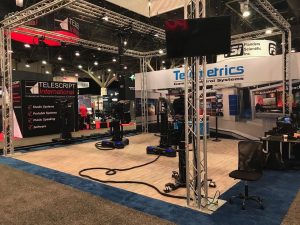NAB 2022 Perspectives: Telemetrics' Michael Cuomo Provides Update to Company's Robotic Cameras, Tracking Systems
Prior to the impact of COVID-19, small-scale organizations and collegiate programs were striving for productions that relied heavily on automation. Whether it was working with shortened crews, looking for ways to capture multiple sports happening simultaneously at various locations, or churning out studio content with a quick turnaround, the effects of the pandemic only exacerbated this dilemma. That’s where Telemetrics comes in. Founded in 1973, the company provides camera control with the development of Triax cable-connected camera control systems, and continues to develop reliable products used in numerous markets.
At the 2022 NAB Show, SVG spoke with Vice President Michael Cuomo to understand what the company was showing at their booth in the Central Hall, how their involvement in sports has grown, what trends they’re currently seeing in the market, and what goals they want to achieve by the end of 2022.

Telemetrics displayed these new products at Booth C5326 in the Central Hall.
What new products or equipment were shown at this year’s show?
The new reFrame Sever — winner of “Best Of Show” by TV Technology — extends the flexibility and highly precise talent tracking of our artificial intelligence (AI)-assisted reFrame Automatic Shot Correction software, running on a RCCP-2A Robotic Camera Control Panel, to more cameras in a production studio or event space. The new reFrame server, which allows multiple cameras to have talent tracking capability simultaneously, also includes an improved UI to make reFrame software easier to set up and operate.
We also showed several new features that streamline workflows and make robotic camera operation faster, easier and more capable than ever before. Among the new features of the RCCP-2A control panel are Prep Execute, Motion Edit, Enhanced Trim Shot, and InFlight Bumping.
The first, Prep Execute, enables users to instruct the robotics to prepare to move to a starting position and when they are ready they can now, with a single button press, execute the move. InFlight Bumping lets operators adjust for last second movement by the talent or changes to the production workflow in real time. So they are pushing or bumping the camera movements “In flight.”
Motion Edit makes shot motions easier to set up and execute. It’s a preset staring position that records everything the operator does and plays it back. It’s great for complicated, nonlinear moves. Previously you had to record the entire move. Now the operator can go back and re-record individual axis.
Finally, Enhanced Trim Shot makes the RCCP-2A more functional than before. There’s a a new User Interface to immediately show the operator which shots are trimmed, which makes it a lot more user friendly. It also makes the trimmed shots a lot more useable.
The RCCP-2A panel was also shown with improved talent tracking in its reFrame AI-assisted talent tracking software, available both the STS Studio and LGS Legislative software packages. New this year (although it was developed in 2020), is Ultra-Wide Band sensors, which add a third layer of tracking to go with its proven facial and object tracking. This offers greatly improved accuracy when tracking people on camera. This also serves as a real-time location or spatial awareness technology that has made reFrame the most accurate and reliable talent tracking software on the market.
Telemetrics has also developed a new multi-function power supply for its robotic camera control systems that includes a small LCD display for labeling purposes as well as diagnostics. The new PS-RM2-48 also includes Ethernet connectivity, giving users the ability to control and monitor the power supply remotely. This also serves as a safety feature because now users can monitor the power that’s being drawn from the power supply.
The new PS-RM2-48 can be used to remotely turn robotic camera components on and off—and it features a lot more juice than previous power supplies. In the past, a Telemetrics OmniGlide rover would require three or four standard power supplies (one for the rover, the Televator, and pan/tilt head). Now, with this new product, users can power all of the components with a single power supply. Therefore, it’s easier to use, takes up less rack space and is more fully featured. The PS-RM2-48 power supply has begun shipping with all new Telemetrics robotic camera systems.
Lastly, we showed several models from its TG4 track system and trolley portfolio, including curved and straight camera track systems mounted on both the ceiling and floor. Based on conversations we had at the show, robotic camera track systems are hot this year, as customers look for new creative ways to produce their shows.
Are there any recent sports partnerships or clients that you’d like to highlight?
We have systems at many MLB, NFL and NHL team venues, including a weatherproof Camera system that is being used by the San Francisco 49ers for their 8K replay system at Levi’s Stadium. We’ve also sold remotely controlled camera rigs to the Associated Press for their (high-resolution still photo) coverage of the Olympics (Summer and Winter) and the past three Super Bowls.
What are some trends that you’re seeing in the industry?
We’re seeing more studio move to robotic cameras as a way to save on costs and cut down on technical errors. Also, sports channels are launching new services from smaller studios and camera robotics is the perfect solution for that. Also, Telemetrics systems can be remotely controlled, cutting down on the number of crew needed on site.
What goals are you looking to achieve by the end of 2022?
Telemetrics will continue to innovate and make our products better, more compact and easier to use, with more features and support for third-party systems based on customer needs.
